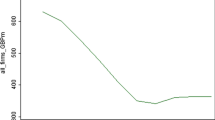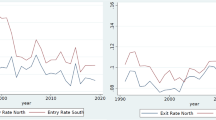Abstract
This paper is an empirical study of inter-industry and inter-temporal variations in entry of new firms using longitudinal data covering all manufacturing establishments in Lower Saxony between 1979 and 1989. Patterns of entry are reported for 29 industries based on numbers of new firms, gross rates of entry, and entry intensities (shares of employees) in different types and size classes of new firms. Entry varies considerably between firm types, industries, and over time. Focussing on entry by small single firms an empirical model is applied to search for industry characteristics that are highly correlated with entry. Pooling of cross-section and time-series data allows to control for influences of varying macroeconomic conditions and unobserved industry characteristics. A highly robust estimation method is applied for the first time in a study of entry rates, and it turns out that extreme observations often have large effect on the results. Entry intensity tends to be positively related to industry growth, concentration, and high unemployment, but negatively to high interest rates, profits, and (insignificantly) to intensive use of capital and R&D. I plead for further research vialearning by asking those who are doing.
Similar content being viewed by others
References
Acs, Zoltan J. and David B. Audretsch, 1989, ‘Births and Firm Size’,Southern Economic Journal 56, 467–475.
Audretsch, David B. and Zoltan J. Acs, forthcoming, ‘New-Firm Startups, Technology, and Macroeconomic Fluctuations’, in Yuichi Shionoya and Mark Perlman (eds.),Innovation in Technology, Industries, and Institutions: Comparative Perspectives, Ann Arbor: University of Michigan Press.
Audretsch, David B. and Michael Fritsch, 1992, ‘Market Dynamics and Regional Development in the Federal Republic of Germany’,Discussion Paper FS IV 92–6, Wissenschaftszentrum Berlin.
Blinder, Alan S., 1990, ‘Learning by Asking Those Who Are Doing’,Eastern Economic Journal XVI, 297–306.
Boeri, Tito, 1990, ‘Wage Differentials, Entry and the Job Generation Process in Germany’,Labour Market and Social Policy Occasional Papers, No. 5, Paris: OECD.
Boeri, Tito and Ulrich Cramer, 1991, ‘Betriebliche Wachstumsprozesse: Eine Statistische Analyse mit der Beschäftigtenstatistik 1977–1987’,Mitteilungen aus der Arbeitsmarkt-und Berufsforschung 24, 70–80.
Brüderl, Josef, Peter Preisendörfer and Rolf Ziegler, 1992, ‘Survival Chances of Newly Founded Business Organizations’,American Sociological Review 57, 227–242.
Brüderl, Josef and Rudolf Schüssler, 1990, ‘Organizational Mortality: The Liability of Newness and Adolescence’,Administrative Science Quarterly 35, 530–547.
Cable, John and Joachim Schwalbach, 1991, ‘International Comparisons of Entry and Exit’, in Paul A. Geroski and Joachim Schwalbach (eds.),Entry and Market Contestability, An International Comparison, Oxford: Basil Blackwell.
Dunne, Timothy and Mark J. Roberts, 1991, ‘Variation in Producer Turnover Across US Manufacturing Industries’, in Paul A. Geroski and Joachim Schwalbach (eds.),Entry and Market Contestability, An International Comparison, Oxford: Basil Blackwell.
von der Fehr, Niels-Henrik M., 1991, ‘Domestic Entry in Norwegian Manufacturing Industries’, in Paul A. Geroski and Joachim Schwalbach (eds.),Entry and Market Contestability, An International Comparison, Oxford: Basil Blackwell.
Freeman, Richard B., 1989,Labour Markets in Action, London: Harvester Wheatsheaf.
Fritsch, Michael, 1992, ‘Regional Differences in New Firm Formation: Evidence from West Germany’,Regional Studies 26, 233–241.
Gerlach, Knut and Joachim Wagner, 1992, ‘Entries, Exits, and the Dynamics of Employment: Lower Saxony, 1978–1990’,mimeo, Institute for Quantitative Economic Research, University of Hannover.
Geroski, Paul A., 1991a,Market Dynamics and Entry, Oxford: Basil Blackwell.
Geroski, Paul A., 1991b, ‘Some Data-Driven Reflections on the Entry Process’, in Paul A. Geroski and Joachim Schwalbach (eds.),Entry and Market Contestability, An International Comparison, Oxford: Basil Blackwell.
Geroski, Paul A. and Robert T. Masson (eds.), 1987, ‘Entry, Exit and Market Dynamics, A Special Issue’,International Journal of Industrial Organization 5, 1–126.
Geroski, Paul A. and Joachim Schwalbach (eds.), 1991,Entry and Market Contestability, An International Comparison, Oxford: Basil Blackwell.
Gorecki, Paul K., 1975, ‘The Determinants of Entry by New and Diversifying Enterprises in the UK Manufacturing Sector 1958–1963: Some Tentative Results’,Applied Economics 7, 139–147.
Gorecki, Paul K., 1976, ‘The Determinants of Entry by Domestic and Foreign Enterprises in Canadian Manufacturing Industries: Some Comments and Empirical Results’,Review of Economic and Statistics 58, 485–488.
Hause, John C. and Gunnar DuRietz, 1984, ‘Entry, Industry Growth, and the Microdynamics of Industry Supply’,Journal of Political Economy 92, 733–757.
Hsiao, Cheng, 1986,Analysis of Panel Data, Cambridge etc.: Cambridge University Press.
ISW, 1992,Der Stand der empirischen Gründungsforschung anhand ausgewählter Studien, Stuttgart: Institut für südwestdeutsche Wirtschaftsforschung.
Khemani, R. S. and D. M. Shapiro, 1988, ‘On Entry and Mobility Barriers’,Antitrust Bulletin, Spring, 115–134.
Mansfield, Edwin, 1962, ‘Entry, Gibrat's Law, Innovation, and the Growth of Firms’,American Economic Review 52, 1023–1051.
Methner, Eckart, 1992, ‘Das Erhebungsprogramm der amtlichen Statistik im Bereich des Produzierenden Gewerbes’, in Rainer Ertel and Joachim Wagner (eds.),Produzieren in Niedersachsen — Empirische Untersuchungen mit Betriebsdaten, Hannover: NIW.
Mueller, Dennis C., 1991, ‘Entry, Exit, and the Competitive Process’, in Paul A. Geroski and Joachim Schwalbach (eds.),Entry and Market Contestability, An International Comparison, Oxford: Basil Blackwell.
Müller, Jürgen, 1987,Beschäftigungswirkungen durch mittelständische Betriebe und Betriebsgründungen. Eine empirische Analyse für den Industriebereich Niedersachsens im Zeitraum 1977 bis 1984, Hannover: Niedersächsisches Institut für Wirtschaftsforschung.
Otremba, Walther, 1980,Marktzugangsbeschränkungen als Problem der Wettbewerbspolitik, Düsseldorf: Mannhold.
Otremba, Walther, 1982, ‘Die empirische Relevanz vom Narktzutrittsbarrieren’,Konjunkturpolitik 28, 190–198.
Rousseeuw, Peter J. and Annick M. Leroy, 1987,Robust Regression and Outlier Detection, New York: Wiley.
Schasse, Ulrich, 1992, ‘Überlebenschancen und Beschäftigungswirkungen neugegründeter Industriebetriebe in Niedersachsen’, in Rainer Ertel and Joachim Wagner (eds.),Produzieren in Niedersachsen — Empirische Untersuchungen mit Betriebsdaten, Hannover: NIW.
Scherer, F. M. and David Ross, 1990,Industrial Market Structure and Economic Performance, Third Edition, Boston etc.: Houghton Mifflin.
Schmalensee, Richard, 1989, ‘Inter-Industry Studies of Structure and Performance’, in Richard Schmalensee and Robert Willig (eds.),Handbook of Industrial Organization, Vol. 2, Amsterdam etc.: North-Holland.
Schwalbach, Joachim, 1987, ‘Entry by Diversified Firms into German Industries’,International Journal of Industrial Organization 5, 43–49.
Schwalbach, Joachim, 1991, ‘Entry, Exit, Concentration, and Market Contestability’, in Paul A. Geroski and Joachim Schwalbach (eds.),Entry and Market Contestability, An International Comparison, Oxford: Basil Blackwell.
Shapiro, Daniel M., 1983, ‘Entry, Exit, and the Theory of the Multinational Corporation’, in Charles P. Kindleberger and David B. Audretsch (eds.),The Multinational Corporation in the 1980s, Cambridge, Mass.: MIT Press.
Sleuwaegen, Leo and Wim Dehandschutter, 1991, ‘Entry and Exit in Belgian Manufacturing’, in Paul A. Geroski and Joachim Schwalbach (eds.),Entry and Market Contestability. An International Comparison, Oxford: Basil Blackwell.
Yamawaki, Hideki, 1991, ‘The Effects of Business Conditions on Net Entry: Evidence from Japan’, in Paul A. Geroski and Joachim Schwalbach (eds.),Entry and Market Contestability, An International Comparison, Oxford: Basil Blackwell.
Author information
Authors and Affiliations
Additional information
This paper is part of the research project “Production, Employment Growth, and Exports by Lower Saxonian Firms”. The computations based on the establishment level data from the official surveys of the manufacturing sector were made possible by a special arrangement between the Ministry of Economics, the Statistical Office, and the Labor Research Group at the Department of Economics, Hannover University. I thank Uwe Rode from the Lower Saxonian Statistical Office for preparing the longitudinal establishment level data base. Financial support from research funds provided by the state of Lower Saxony is gratefully acknowledged.
Rights and permissions
About this article
Cite this article
Wagner, J. Small firm entry in manufacturing industries: Lower Saxony, 1979–1989. Small Bus Econ 6, 211–223 (1994). https://doi.org/10.1007/BF01108289
Received:
Issue Date:
DOI: https://doi.org/10.1007/BF01108289




